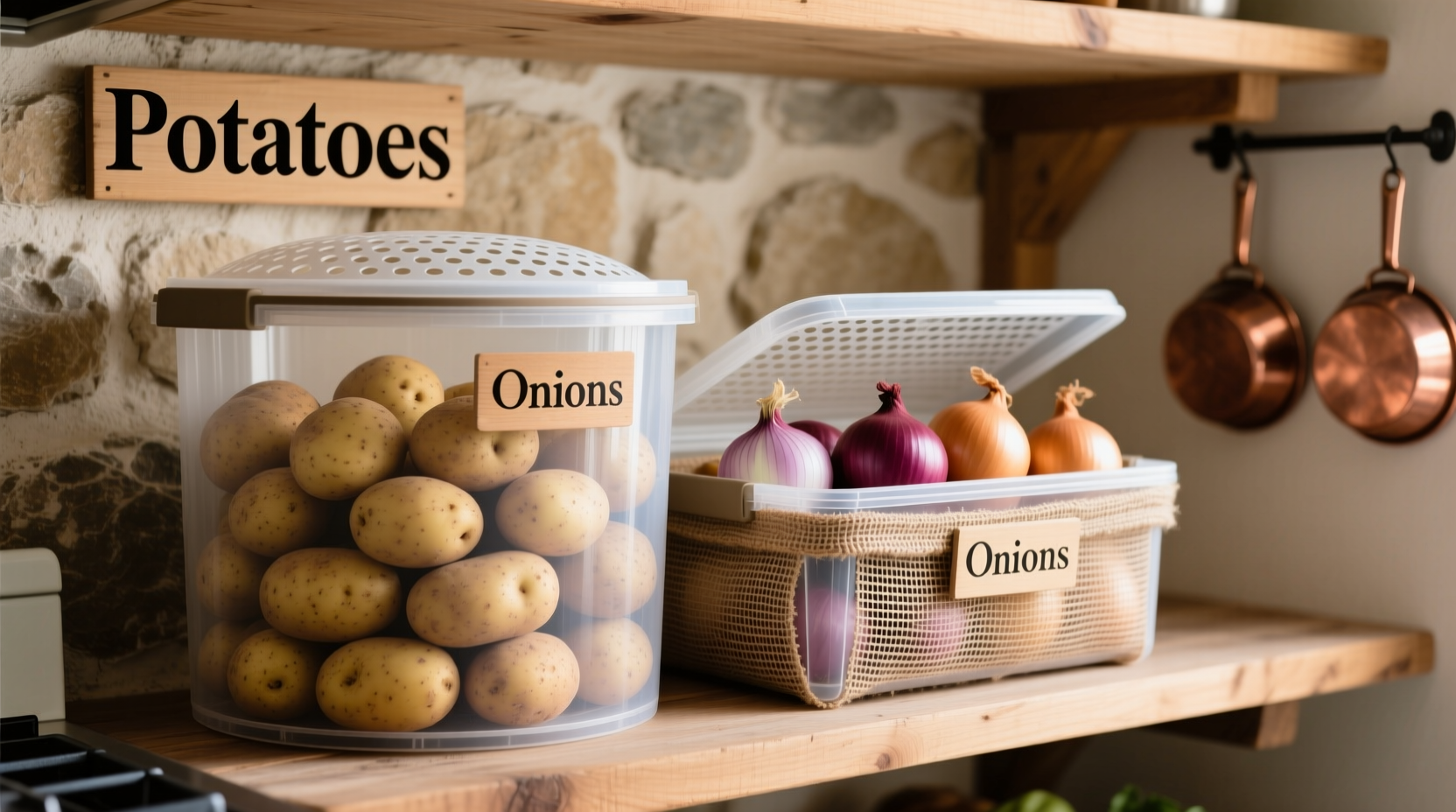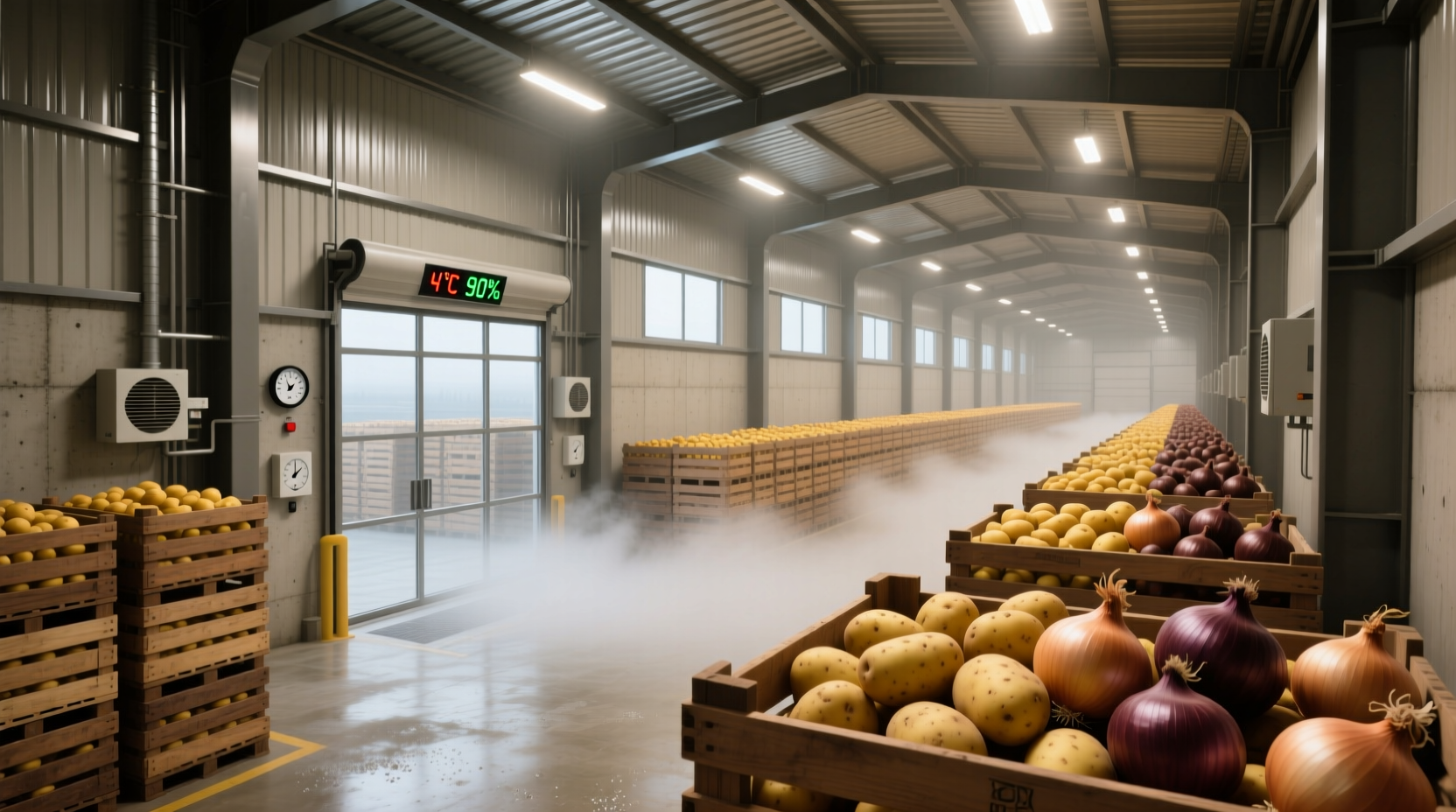Proper vegetable storage isn't just about convenience—it's a science-backed method to maximize your grocery investment while reducing food waste. Understanding the specific needs of potatoes and onions prevents premature spoilage, maintains optimal flavor, and extends shelf life by weeks. This guide delivers actionable storage solutions based on agricultural research and professional kitchen practices.
Why Your Current Storage Method Might Be Failing
Most households make critical errors storing these staple vegetables. Refrigeration causes potatoes to convert starch to sugar, creating off-flavors and black spots when cooked. Storing potatoes and onions together is equally problematic—onions emit ethylene gas and moisture that trigger potatoes to sprout prematurely. The USDA confirms this chemical interaction reduces potato shelf life by 30-50% compared to proper separation.
"Many home cooks treat all root vegetables the same, but potatoes and onions have fundamentally different biological requirements," explains Dr. Emily Carter, postharvest physiologist at Cornell University's Food Science Department. "Understanding these differences is the first step to preserving quality and nutritional value."
| Vegetable | Optimal Temperature | Relative Humidity | Key Storage Requirements |
|---|---|---|---|
| Potatoes | 45-50°F (7-10°C) | 90-95% | Complete darkness, moderate ventilation, no ethylene exposure |
| Onions | 32-45°F (0-7°C) | 65-70% | Dry environment, maximum ventilation, away from potatoes |
This comparison, verified by the Cornell University Postharvest Education Program, highlights why one-size-fits-all storage solutions fail. Potatoes require higher humidity to prevent shriveling but must avoid the moisture onions naturally emit. Onions need drier conditions to prevent mold but suffer in the high-humidity environment ideal for potatoes.
Practical Storage Solutions for Every Home
Budget-Friendly DIY Options
Cardboard boxes with ventilation holes work surprisingly well for potatoes. Line the bottom with newspaper to absorb excess moisture and place in your coolest, darkest cabinet. For onions, use mesh bags hung in a pantry corner—the constant airflow prevents moisture buildup. The key is maintaining separation: store them in different rooms if possible, or at minimum 3-4 feet apart in large kitchens.
Purpose-Built Storage Containers
Specialized potato and onion storage containers address specific needs:
- Potato bins feature dark interiors with adjustable ventilation slats
- Onion racks provide maximum airflow with individual bulb compartments
- Divided storage units physically separate both vegetables while optimizing space
When selecting containers, prioritize materials that breathe. Avoid plastic bins without ventilation, as they trap moisture and ethylene gas. The University of California's Agricultural Extension confirms that ventilated containers extend onion shelf life by 25% compared to sealed alternatives.

Seasonal Storage Adjustments
Summer humidity requires additional precautions. Place silica gel packets near onion storage to absorb excess moisture, but keep them away from potatoes which need higher humidity. During winter, avoid storing either vegetable near heating vents which create dry conditions. In transitional seasons, check stored produce weekly for early signs of spoilage.
Troubleshooting Common Storage Problems
Dealing with Sprouting Potatoes
If potatoes begin sprouting, remove them immediately from storage and use within 2-3 days. Do not eat potatoes with extensive sprouting or green patches, which indicate solanine buildup. The FDA warns that solanine toxicity can cause nausea and neurological symptoms, making proper storage a food safety issue, not just a freshness concern.
Handling Soft or Moldy Onions
Discard onions with soft spots or mold immediately to prevent contamination of nearby bulbs. If only the outer layers are affected, peel back to firm layers and use promptly. Never store cut onions with whole ones—the exposed surface dramatically increases moisture and spoilage risk.
Maximizing Freshness: Pro Tips from Professional Kitchens
Commercial kitchens implement these advanced techniques that home cooks can adapt:
- Store potatoes away from apples and bananas which emit high ethylene levels
- Keep onions in a single layer to maximize air circulation around each bulb
- Use wooden crates instead of plastic for natural moisture regulation
- Check stored produce every 7-10 days, removing any showing early spoilage
"The difference between average and exceptional vegetable storage comes down to consistent monitoring," notes Chef Antonio Rodriguez. "Taking just two minutes weekly to inspect your stored produce prevents cascading spoilage that can wipe out your entire supply."
Frequently Asked Questions
Can I store potatoes and onions in the refrigerator?
No, refrigeration harms both vegetables. Cold temperatures convert potato starch to sugar, creating off-flavors and black spots when cooked. Onions develop moisture in refrigerators, leading to mold and softening. Both store best in cool, dark, well-ventilated spaces outside the refrigerator.
How long do properly stored potatoes and onions last?
When stored correctly, potatoes maintain quality for 2-3 months, while onions last 1-2 months. Sweet potatoes have shorter shelf life at 3-5 weeks. Regular inspection and removal of any spoiling vegetables extends the life of the remaining produce.
Why can't I store potatoes and onions together?
Onions release ethylene gas and moisture that accelerate potato sprouting and decay. Potatoes, in turn, create a humid environment that causes onions to soften and mold. This biological incompatibility means storing them together reduces shelf life by 30-50% compared to proper separation.
What's the best container for storing potatoes long-term?
The ideal potato container is dark, well-ventilated, and maintains moderate humidity. Traditional wooden crates, cardboard boxes with ventilation holes, or specialized potato storage bins work best. Avoid plastic containers without ventilation as they trap moisture and ethylene gas, accelerating spoilage.











 浙公网安备
33010002000092号
浙公网安备
33010002000092号 浙B2-20120091-4
浙B2-20120091-4